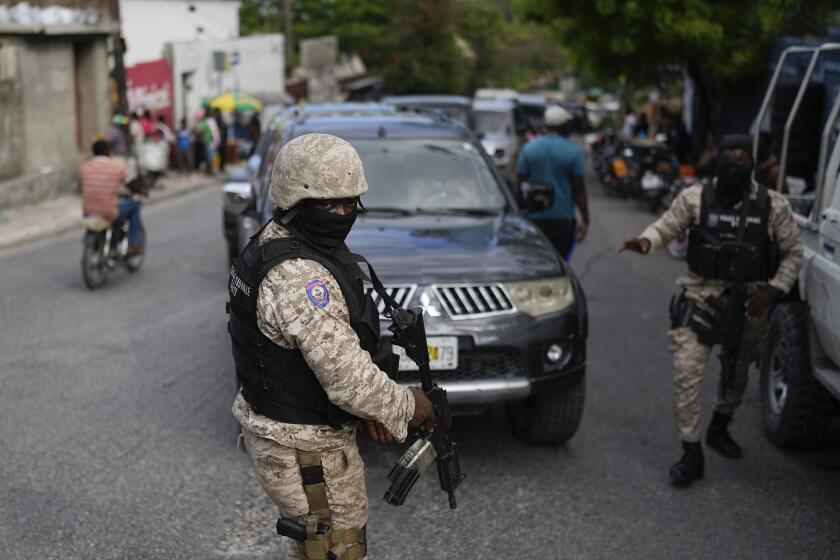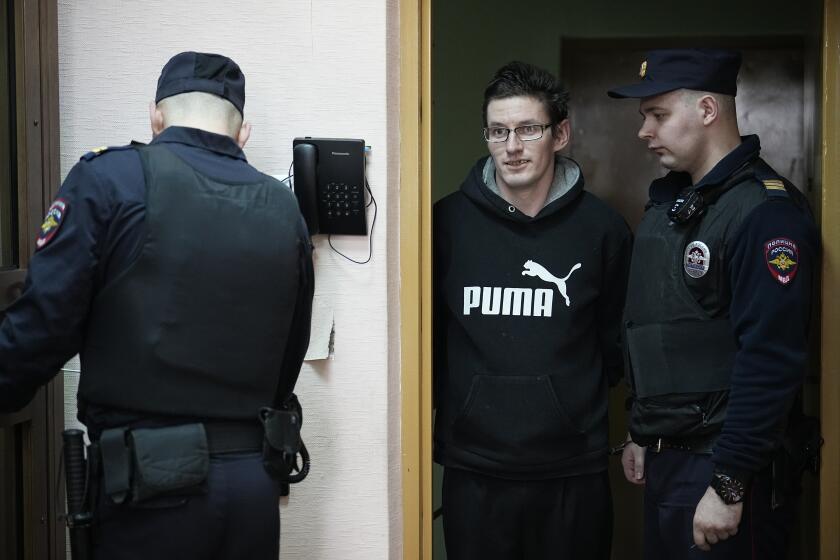$400 Lap Dance Trips Up Counterfeiting Ring
It was a three-hour lap dance and a stripper with a nose for money that finally led to the counterfeiters’ undoing.
Fifteen people have been indicted in the ongoing investigation. And Secret Service agents have discovered that Southern California street gangs teamed with a Mexican counterfeit ring and a drug cartel to bring phony $100 bills into the United States -- $7.5 million worth since last January alone.
The bills were unloaded in Los Angeles and Orange counties, as well as with gangs in Spokane, Wash., and New Orleans.
Tony Chapa, former head of the Secret Service’s counterfeit division in the nation’s capital, said that counterfeiting -- once considered relatively nonviolent -- is attracting violent criminals. He said that Colombian counterfeiting rings, considered among the most prolific, often work in tandem with that country’s drug cartels.
“Both groups use the same mules [couriers]. One month a mule will be transporting drugs to Los Angeles or Miami, and the next month he’s bringing in counterfeit notes,” said Chapa, who now heads the agency’s Los Angeles office.
He said this latest case was only the second in his 20-year career in which he had seen counterfeit U.S. currency originating in Mexico.
The powerful drug gang run by Joaquin “Chapo” Guzman, which controls narcotics distribution along much of Mexico’s Pacific Coast, helped the counterfeiting ring bring the bills into the United States through its drug smuggling routes, in a manner similar to the Colombians, Chapa said.
The quality of the counterfeit notes was high, Chapa said. The bills were printed on an offset press in Guadalajara, the same process the U.S. Bureau of Engraving and Printing uses.
“There’s a lot of skill needed to produce an offset note,” he said. “Most counterfeit notes are digitally produced and very easy to identify.”
Authorities said the Southern California ringleader, Jose Carlos Gonzalez-Moreno, lived in a modest home in Santa Ana. Guzman and Gonzalez-Moreno, who was indicted by a federal grand jury in Santa Ana on counterfeiting charges, are believed to be hiding in Mexico.
The counterfeit bills first turned up in Mexico, where banks recognized them and returned them to the merchants who had accepted them, said James Kollar, head of the Secret Service office in Santa Ana. The ring shifted its operation to Southern California, where Orange County merchants and banks began reporting the bogus currency in early 2002.
Agents got their first break that September. Based on information from informants, undercover agents recovered more than $300,000 in bogus $100 bills from a car belonging to Alfonso Avila Macias, 30, of Santa Ana. He was not charged until three years later, as investigators hoped he would lead them to the ring’s leaders.
Instead, he and the other suspects figured out what the agents were up to, and the investigation stalled for two years -- until Luis Gabriel Cisneros visited the Sahara Theater in Anaheim in December 2004.
After his three-hour lap dance, he paid the 20-year-old stripper with four $100 bills. He had 11 more stashed in his right sock, agents said. The bills looked genuine, but they smelled like vinegar. The stripper told a club employee, who called police.
Secret Service agents said they believed the bills were doused in vinegar to fool dogs used to sniff out contraband at the border. None of the bill smugglers were caught by Border Patrol agents, Kollar said. The couriers were almost always women, the agents said they later learned, who would walk across the border at San Ysidro with as much as $200,000 in fake bills hidden in their undergarments.
After Cisnero’s arrest, Secret Service agents found themselves back on the trail of the counterfeit ring. “It was kind of a Christmas gift for us,” Kollar said.
Cisneros, 23, pleaded guilty last year to possessing counterfeit money and using it to pay for services. He faces up to 20 years in federal prison when he is sentenced in March.
Secret Service officials allowed two undercover agents to talk to The Times on the condition that they would not be identified. The agents said the gangs they infiltrated were also dealing drugs and guns. In one instance, they said, agents tracked a Santa Ana gang member who had gone to Spokane with counterfeit bills that he sold to gang members there. The man drove back to Orange County in a Cadillac Escalade purchased with money from the sale.
Gonzalez-Moreno, who received the bills directly from the Mexican counterfeiters, sold the bogus currency at 18% of face value, agents said. The distributors, who were often gang members, resold the counterfeit notes for 25% to 40% of face value.
Distributors placed orders through Gonzalez-Moreno, and payment was wired to the counterfeiters in Mexico via Western Union, agents said. “We could order $100,000 through an informant and get it the next day; $3 million would take a couple of weeks,” an agent said.
Kollar said gang members and their associates also passed the bogus money in malls, where they made purchases and returned the items for refunds.
One of their friends tried to launder the bills at a Macy’s in Santa Ana, where he was working. Store officials called the Secret Service after they noticed an influx of counterfeit bills. It turned out, Kollar said, that one night the man exchanged $3,000 for counterfeit bills.
By the middle of 2005, several people had been arrested on suspicion of passing the bills, and gang members realized that the Secret Service was on to them, Kollar said.
The agency’s Santa Ana office is blocks from the neighborhood where much of the case unfolded. Gang members watched the building and would tail agents when they drove out of the garage, he said.
In one instance, eight to 10 gang members surrounded and rocked a parked van with two agents inside who were watching a suspect, said an agent. It was not clear to the men whether the gangsters knew they were Secret Service or whether they were letting an unfamiliar vehicle know that this was their turf.
Infiltrating street gangs is not something Secret Service agents routinely do, said Kollar. But the three-year probe by his agents was memorable for another reason.
“It takes a skillful crook to do this kind of counterfeiting,” he said, “which makes an investigation like this exciting.”
More to Read
Start your day right
Sign up for Essential California for news, features and recommendations from the L.A. Times and beyond in your inbox six days a week.
You may occasionally receive promotional content from the Los Angeles Times.






